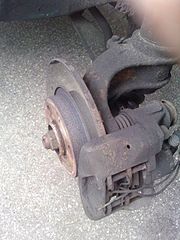Brake caliper
The brake caliper (more rarely: brake caliper ) is the part of a disc brake that clamps the brake pads over the brake disc. With hydraulic actuation, the linings are pressed onto the brake disc by one or more movable pistons, with mechanical actuation by appropriate levers.
Basics
Brake calipers are mostly made of cast iron. Basically one differentiates between
- Fixed saddle
- Floating saddle
- Pendulum saddle (also: tipping semitrailer ).
Fixed saddle
The fixed caliper carries at least two opposing brake pistons that press the pads onto the disc. It is also possible to arrange several pistons next to one another on the inside and outside, which improves the pressure distribution on the contact surface of the pad and disc. In addition to the braking performance, this primarily optimizes braking comfort.
A special form of the fixed caliper is the single-piston fixed caliper brake, as it is sometimes used in modern bicycle disc brakes. Here, the disc is mechanically deformed by the piston and the left brake pad and pressed against the stationary right pad. A comparatively simple and light brake with good braking properties was thus possible. The deformation of the disc is minimal (<1 mm) and not permanent.
Floating saddle
When floating caliper or caliper of the piston is arranged behind one of the two friction pads, while the piston away from the brake pad is fixedly secured to the floating caliper. In the case of wheel brakes, the piston is usually located on the side of the caliper facing away from the wheel, due to the small installation space available. The floating caliper is mounted displaceably (floating) in the axial direction of the brake disc. If the piston is pressurized, the floating caliper aligns itself thanks to its linear guide so that both brake pads are pressed onto the brake disc with the same force. In the course of the wear of the friction linings, the brake caliper moves in the direction of the piston by the amount of wear on the friction lining further away from the piston, while the piston moves in the opposite direction by the amount of wear on both friction linings.
Pendulum saddle
The pendulum saddle ( tipping semitrailer ) has only one piston in the rule. The brake caliper is rotatably mounted about an axis which is perpendicular to the axis of rotation of the brake disc. As the brake caliper wears, it rotates or tilts. New brake pads have a wedge-shaped cross-section that approximates a rectangular cross-section as it wears. This design has not caught on because of the uneven pad wear and the associated uneven braking effect over the period of wear.
Mode of action
With every hydraulic actuation of the brakes, the pressure distribution on the contact surface of the pad and disc can be improved by arranging several hydraulic pistons next to one another.
The side of the pad on which the rotating disc first comes into contact with the brake lining is accruing side called the other side of the running side . The braking effect on the approaching side is in principle stronger because the brake lining tends to wedge due to the rotation of the disc. If several hydraulic pistons are applied to a brake lining, a smaller piston can be provided on the running side, which exerts less force, in order to ensure even wear.
The brake caliper is basically connected to a torque arm that is fixed in relation to the wheel.
literature
- Hans-Hermann Braess, Ulrich Seiffert: Vieweg manual automotive technology. 2nd edition, Friedrich Vieweg & Sohn Verlagsgesellschaft mbH, Braunschweig / Wiesbaden 2001, ISBN 3-528-13114-4 .
- Peter Gerigk, Detlev Bruhn, Dietmar Danner: Automotive engineering. 3rd edition, Westermann Schulbuchverlag GmbH, Braunschweig 2000, ISBN 3-14-221500-X .
- Max Bohner, Richard Fischer, Rolf Gscheidle: Expertise in automotive technology. 27th edition, Verlag Europa-Lehrmittel, Haan-Gruiten 2001, ISBN 3-8085-2067-1 .
